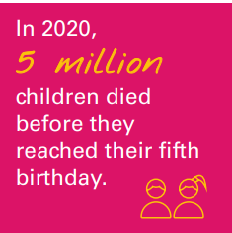
This week’s topic, hunger and its devastating impacts on children, is an especially difficult one. The suffering of children asks much of our minds and hearts. And there is so much to say about chronic hunger and malnutrition in children, much more than one Small Sip can hold.
Let's make a start.
Malnutrition’s Lifelong Effects
We know that malnutrition at any age is harmful, but it is especially devastating for children, because they are new and growing little humans with unique nutritional needs for healthy development. Access, or the lack of access, to adequate nutrition right from the start, sets the stage for the rest of their lives.
Insufficient nutrition affects a child’s physical and cognitive development and impedes their chances of reaching their full potential later in life. Malnutrition at an early age permanently affects brain development, immunity, and health. Chronically malnourished children risk facing a future marked by illness, compromised learning, and poverty, with consequences across generations.
The First 1000 Days
The foundations for healthy, lifelong physical growth and mental development are laid in the crucial first 1000 days of life, from pregnancy to a child’s second birthday. Malnutrition during this critical period can have particularly devastating lifetime impacts on health and well-being. Lack of proper nutrition during the first 1000 days can permanently damage physical growth (including brain development), leading to a diminished capacity to learn and a greater susceptibility to infection. This critical nutritional window has implications not just for babies and toddlers, but for mothers as well. Maternal malnutrition can lead to low birthweight, infant mortality, preterm delivery, and slow cognitive development for her baby. Maternal health and nutrition and child health and nutrition are inseparable.
Childhood Malnutrition: Wasting, Stunting, Hidden Hunger, and Overweight
We have encountered these words before. We will now look at them more closely.
Wasting, or rapid weight loss, is the most immediate, visible, and life-threatening form of malnutrition. It is characterized by low body weight in relation to height. Wasting weakens a child’s immune system, leaving them vulnerable to developmental delays, disease, and death. Wasting and other forms of acute malnutrition are the result of maternal malnutrition, low birthweight, poor feeding and care practices, and infection, compounded by food insecurity, limited access to safe drinking water, and poverty. The number of children who suffer from wasting can increase dramatically as a result of conflict, epidemics and food insecurity, including that caused by climate change–induced droughts and flooding. Yet, wasting is not only present during crises. It is also experienced in places not facing emergencies. When efforts to prevent malnutrition fall short, early detection and treatment of children with wasting and other life-threatening forms of malnutrition are critical to save their lives and put them on the path to healthy growth and development. In most cases, children with wasting can be treated with ready-to-use therapeutic food (RUTF), allowing them to recover in their own homes and communities rather than in a health facility.1
Stunting is a sign of chronic malnutrition. It is a slow cumulative process resulting from inadequate nutrition over time. Stunting is an irreversible condition that literally stunts the physical and cognitive growth of children. It is measured in terms of low height for age in a child. Children who are stunted are more susceptible to dying from infections and are predisposed to becoming overweight and to developing diet-related noncommunicable diseases later in life. Stunting is associated with poor cognitive development and, therefore, can impact a child’s future life prospects. Author Roger Thurow has referred to stunting as “a life sentence of underachievement and underperformance” that prevents children, families, communities, and nations from reaching their full potential.
Hidden hunger refers to a lack of essential micronutrients in a child’s diet – the vitamins and minerals needed for healthy development. In many lower-income communities in the Global South, diets consist predominantly of grain crops, rich in carbohydrates but limited in vitamins and minerals. These diets fill stomachs, but do not supply enough of the micronutrients that children need for proper growth and development and the ability to fight off infection and disease. This hunger is called hidden because there may not be any visible signs that micronutrient deficiency is occurring. Micronutrients like Vitamin A, iodine, iron and zinc are especially important to a child’s development. Vitamin A deficiency weakens the immune system and increases the risk of contracting infectious diseases and can result in visual impairment and blindness. Iodine deficiency results in poor brain development, with the potential for severe mental impairment. Iron deficiency results in anemia, causing delayed growth and development. Zinc deficiency can lead to major organ system failures, including of the gastrointestinal track, which leads to severe diarrhea.
Overweight is also a sign of malnutrition. It is measured in terms of high weight for height. Children who are overweight or obese face both immediate and potentially long-term health impacts. Immediate impacts include respiratory difficulties, increased risk of fractures, hypertension, early markers of cardiovascular disease, insulin resistance, and psychological effects. In the long term, overweight children have a higher risk of noncommunicable diseases later in life. Once thought of as a condition of the wealthy, overweight is now increasingly a disease of the poor, reflecting the greater availability in most countries of "cheap calories" from processed foods that are often high in salt, sugars, and fats, and low in essential nutrients and fibre.
The Numbers
In 2020 (the most recent year for which statistics are available), it is estimated that, around the world, 45 million children under 5 years of age suffered from wasting, 149 million from stunting, and 39 million from overweight.2

Child Nutrition and Mortality
Malnourished children have a higher risk of death from common childhood illnesses such as diarrhea, pneumonia, and malaria. Nutrition-related factors contribute to about 45% of all deaths in children under 5 years of age each year.3 5 million children under 5 died in 2020. Malnutrition played a role in the deaths of 2.25 million of them.
Dig Deeper…
For those interested in learning more about children and hunger, here is a selection of recommended resources:
- Read the urgent Call to Action launched on January 12, 2023 by five UN agencies, calling for accelerated action on child wasting in the 15 countries hardest-hit by the current global food crisis. The 15 countries are home to more than 30 million acutely malnourished children. Twelve of the 15 worst-affected countries are in Africa.
- Early Childhood Malnutrition and Humanitarian Emergencies -- A clear and thorough Backgrounder from the World Food Program USA
- Stunting Is a ‘Life Sentence of Underachievement and Underperformance’ -- New Humanitarian interview with Roger Thurow, author of The First 1,000 Days: A Crucial Time for Mothers and Children – and the World. [The interview dates back to 2017 but is well worth reading.]
- Informative articles from UNICEF on child stunting in Eastern and Southern Africa, on child wasting, and on severe child wasting.
- Ending child hunger and food insecurity needs to be a top priority in Canada as well as globally -- Article by Tina Moffat, Associate Professor, Department of Anthropology, McMaster University, addressing the issue of child hunger in Canada
Some final thoughts...
“We already know so much of what works to prevent malnutrition in all its forms, from conception, through early childhood and into adolescence. But this is a battle we cannot win on our own. It needs the political determination of national governments, backed by clear financial commitments, as well as policies and incentives that encourage the private sector’s investment in nutritious, safe and affordable food for children, young people, women, and families. And, increasingly, it needs a determination to make children’s nutrition a priority across not just the food system but also in the health, water and sanitation, education and social protection systems. Success in each of these supports success in all. ... Good nutrition paves the way for a fair chance in life. Let us work together to lower these barriers and to ensure that every child, young person, and woman has the nutritious, safe, affordable, and sustainable diets they need at every moment of life to meet their full potential.” -- Henrietta H. Fore UNICEF Executive Director (2018 – 2022) in The State of the World’s Children 2019 Children, Food, and Nutrition: Growing Well in a Changing World.
[This is the fifth installment in GRAN's Small Sips series on The Right to Food.]



